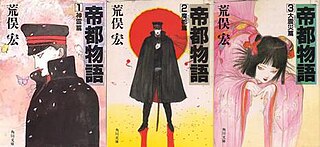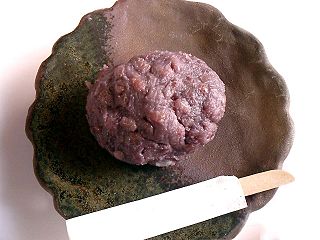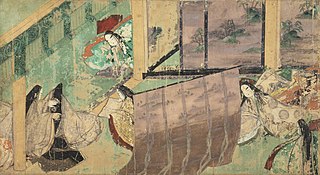Emperor En'yū was the 64th emperor of Japan, according to the traditional order of succession.

Maeda Toshiie was one of the leading generals of Oda Nobunaga following the Sengoku period of the 16th century extending to the Azuchi–Momoyama period. His father was Maeda Toshimasa. He was the fourth of seven brothers. His childhood name was "Inuchiyo" (犬千代). His preferred weapon was a yari and he was known as "Yari no Mataza" (槍の又左), Matazaemon (又左衛門) being his common name. The highest rank from the court that he received is the Great Counselor Dainagon (大納言).

The Japonic or Japanese–Ryukyuan language family includes the Japanese language, spoken in the main islands of Japan, and the Ryukyuan languages, spoken in the Ryukyu Islands. The term Japonic was coined by Leon Serafim, and the family is universally accepted by linguists. The common ancestral language is known as Proto-Japonic or Proto-Japanese–Ryukyuan. The essential feature of this classification is that the first split in the family resulted in the separation of all dialects of Japanese from all varieties of Ryukyuan. According to Shirō Hattori, this separation occurred during the Yamato period (250–710).
The Yonaguni language is a Southern Ryukyuan language spoken by around 400 people on the island of Yonaguni, in the Ryukyu Islands, the westernmost of the chain lying just east of Taiwan. It is most closely related to Yaeyama. Due to the Japanese policy on languages, the language is not recognized by the government, which instead calls it the Yonaguni dialect. As classified by UNESCO, the Yonaguni language is the most endangered language in all of Japan.
Monogatari (物語) is a literary form in traditional Japanese literature, an extended prose narrative tale comparable to the epic. Monogatari is closely tied to aspects of the oral tradition, and almost always relates a fictional or fictionalized story, even when retelling a historical event. Many of the great works of Japanese fiction, such as the Genji monogatari and the Heike monogatari, are in this monogatari form.

Yamato-e (大和絵) is a style of Japanese painting inspired by Tang dynasty paintings and fully developed by the late Heian period. It is considered the classical Japanese style. From the Muromachi period, the term Yamato-e has been used to distinguish work from contemporary Chinese-style paintings, which were inspired by Chinese Song and Yuan-era ink wash paintings.

Otogi-zōshi (御伽草子) refers to a group of about 350 Japanese prose narratives written primarily in the Muromachi period (1392–1573). These illustrated short stories, which remain unattributed, together form one of the representative literary genres of the Japanese medieval era.

Teito Monogatari is an epic historical dark fantasy/science fiction work; the debut novel of natural history researcher and polymath Hiroshi Aramata. It began circulation in a literary magazine owned by Kadokawa Shoten in 1983, and was published in 10 volumes over the course of 1985–1987. The novel is a romanticized retelling of the 20th-century history of Tokyo from an occultist perspective.
Takehiko Itō is a Japanese manga artist best known for his work on the manga Outlaw Star from his affiliated Morning Star Studio. He was also the primary creative mind behind other works of fiction set in the Toward Stars universe including the Uchuu Eiyuu Monogatari manga and Angel Links anime series.

The Story of Saiunkoku is a series of Japanese light novels written by Sai Yukino and illustrated by Kairi Yura. As of July 2011, the eighteenth and final volume was released, concluding the series. Four side story anthologies have also been released, collecting stories originally published in The Beans magazine.

Botamochi are a Japanese sweet made with glutinous rice, rice and sweet azuki paste. They are made by soaking glutinous rice mixed rice for approximately 1 hour. The rice is then cooked, and a thick azuki paste is hand-packed around pre-formed balls of rice. Botamochi is eaten as sacred food as offering during the weeks of the spring and the autumn Higan in Japan.

Hyakki Yagyō, variation: Hyakki Yakō, is an idiom in Japanese folklore. Sometimes an orderly procession, other times a riot, it refers to an uncontrolled horde of countless numbers of supernatural creatures known as oni and yōkai. As a terrifying eruption of the supernatural world into our own, it is similar to the concept of pandemonium in English.

Shippeitaro or Shippei Taro is the name of a helper dog in the Japanese fairy tale by the same name.
Minamoto no Takakuni (1004–1077), also known as Uji Dainagon (宇治大納言), was a noble and a scholar of ancient Japan. He was also the father of Toba Sōjō, an important painter.
Shimotsukare(しもつかれ) is a local Japanese dish served in Northern Kantō region of Japan, Tochigi Prefecture, Gunma Prefecture and Ibaraki Prefecture. The dish is generally served on hatsu-u-no hi together with sekihan as an offering to appease the legendary deity, inari. Shimotsukare is usually made by simmering vegetables, soybeans, abura-age and sake kasu. Common additional ingredients include grated raw radish and carrots. The dish is also known as shimitsukari, shimitsukare or sumitsukare in some areas.
Tsutsumi Chūnagon Monogatari is a post late-Heian period Japanese collection of short stories.
The Okamoto Kyōsai Zatcho (岡本況斎雑著) is the 226-volume collected works of the Japanese kokugaku scholar Okamoto Yasutaka. It was compiled after Yasutaka's death by an unknown editor, based on Yasutaka's manuscripts that had entered the holdings of Seikadō Bunko.
Tenshō-daijin Honji (天照大神本地) is a Japanese otogi-zōshi in one book, composed in the early sixteenth century.














